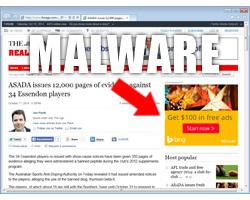Malvertising, the Hack That Infects Computers Without a Click
Posted by: Timothy Weaver on 12/11/2015 11:22 AM
[
 Comments
]
Comments
]
Malvertising is when hackers buy ad space on a legitimate website, and, as the name suggests, upload malicious advertisements designed to hack site visitor’s computers.
 No site is not susceptible to the malware. Such popular porn sites such as PornHub and YouPorn dished out malicious ads in September. The Huffington Post, a site with 100 million unique monthly visitors, was serving up malware. Both DrudgeReport and Yahoo! were also hit by malvertising campaigns this year, and Forbes fell victim in September.
No site is not susceptible to the malware. Such popular porn sites such as PornHub and YouPorn dished out malicious ads in September. The Huffington Post, a site with 100 million unique monthly visitors, was serving up malware. Both DrudgeReport and Yahoo! were also hit by malvertising campaigns this year, and Forbes fell victim in September.
Researchers at malware-security company Cyphort reported a 325 percent increase of malvertising attacks between June 2014 and February 2015.
Hélène Barrot, a representative from Google, said: “In 2014, we disabled more than 524 million bad ads and we banned more than 214,000 bad advertisers."
At the moment, malvertising is incredibly cheap for cybercriminals to carry out. For some ad networks, hackers are “able to put malicious ads in front of a thousand people for only 30 cents. You can’t get any cheaper than that.”
Source: Wired
 No site is not susceptible to the malware. Such popular porn sites such as PornHub and YouPorn dished out malicious ads in September. The Huffington Post, a site with 100 million unique monthly visitors, was serving up malware. Both DrudgeReport and Yahoo! were also hit by malvertising campaigns this year, and Forbes fell victim in September.
No site is not susceptible to the malware. Such popular porn sites such as PornHub and YouPorn dished out malicious ads in September. The Huffington Post, a site with 100 million unique monthly visitors, was serving up malware. Both DrudgeReport and Yahoo! were also hit by malvertising campaigns this year, and Forbes fell victim in September.Researchers at malware-security company Cyphort reported a 325 percent increase of malvertising attacks between June 2014 and February 2015.
Hélène Barrot, a representative from Google, said: “In 2014, we disabled more than 524 million bad ads and we banned more than 214,000 bad advertisers."
At the moment, malvertising is incredibly cheap for cybercriminals to carry out. For some ad networks, hackers are “able to put malicious ads in front of a thousand people for only 30 cents. You can’t get any cheaper than that.”
Source: Wired
Comments






